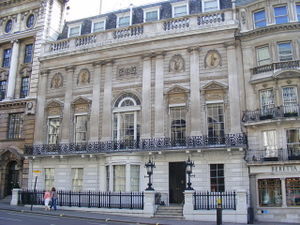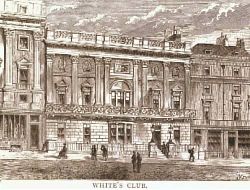White's: Difference between revisions
(Created page) |
No edit summary |
||
| (13 intermediate revisions by the same user not shown) | |||
| Line 1: | Line 1: | ||
[[ | <table class="infobox" align="right" bgcolor="#E1E1E1" style="width:300px; font-size:90%; text-align:left; border: 1px #f18c77 solid;"> | ||
<caption style="text-align:center; font-size:140%;"><i><b>White's</b></i></caption> | |||
<tr> | |||
<td colspan="2" style="text-align:center;" bgcolor="#f18c77">[[File:White's_club.jpg|250px]]</td> | |||
</tr> | |||
<tr> | |||
<td colspan="2" bgcolor="#f18c77" style="text-align:center;">A contemporary engraving of the exterior of White's</td> | |||
<tr> | |||
<th>Official Name</th> | |||
<td>White's</td> | |||
</tr> | |||
<tr> | |||
<th>Type of Establishment</th> | |||
<td>Gentlemen's club</td> | |||
</tr> | |||
<tr> | |||
<th>Founded in</th> | |||
<td>1693</td> | |||
</tr> | |||
<tr> | |||
<th>Location</th> | |||
<td>37-38 St James Street</td> | |||
</tr> | |||
<tr> | |||
<th>Cost of Membership</th> | |||
<td>10 guineas per annum </td> | |||
</tr> | |||
<tr> | |||
<th>Political Affiliation</th> | |||
<td>Mainly Tory</td> | |||
</tr> | |||
</table> | |||
[[file:White's_Club.jpg|right|thumb|300px|White's Club, 37-38 St James' Street]][[White's]] is the oldest and most prestigious of the [[Gentlemen's Clubs|gentlemen's clubs]], being founded in 1693 as a chocolate shop. Its Italian founder, Francisco Bianco, changed his name to Francis White and the club was named for him. Politically, the club was conservative, which led to having many Tory members. It is located at 37-38 St James' Street, London, on the east side of the street. By 1723 it had become the great stronghold of the Tory party, with 500 members, all wealthy and aristocratic and fulfilling, in social status, the standard deemed necessary for admission to the club. White's is by far the most difficult of all the clubs to enter and does not permit the admission of 'trademen' as some of its members regard bankers and merchants. | |||
The rules of the club (White's), dating from 1781, laid down the ten guineas annual membership, procedures for terminating subscriptions and for "blackballing" aspiring candidates. The rules also stipulated that the 300-strong membership was to be renewed every time it fell to 280 by 20 new members chosen by a committee. | |||
As party animosities intensified in the 1780s, [[Brooks's]] and White's became intensely partisan. When the younger Pitt was elected to White's in 1783, Fox and his Whig friends seceded to Brooks's, and thenceforth White's remained Pittite territory while Brooks's became the base of the opposition Whigs. White's had been established as a refuge for Tory grandees, but by 1800 its politics were subordinate to its social preeminence to the extent that Brummell, a notional Whig, could become a leading member. | |||
[[Almack's]] was not the only club that threw balls in the evening. White's also did on occasions considered worthy of committee members' attention. | |||
At White's, there had existed since 1743 a betting book in which members recorded some of their private wagers. They did this as a safeguard against convenient lapses of memory, and also, it would seem, for the entertainment of the club at large. Members (at Brooks's and White's) bet on horses and prizefighters, as one might expect. They also bet on the sex of their own children, or of other people's children or of their mistresses. They bet with macabre frequency on the imminent deaths of friends and enemies and on each other's illnesses, and on the tragic degeneration of the old king's mental state. | |||
[[File:White's club floorplan.jpg|right|thumb|300px|Floorplan of White's, c.1800]]To become a member, a man must be proposed by a current member, and a system of black and white balls was used to vote on the prospective man's membership. A single black ball was enough to exclude him from becoming a member, giving rise to the term 'blackballed'. This system was not exclusive to White's, being used in other clubs.<ref>[http://www.thelondonliferpg.com/forums/index.php?/topic/1678-club-memberships/?p=19116 Club Membership, on the board]</ref> | |||
==Members== | ==Members== | ||
* | [[File:Whites_club.jpg|right|thumb|300px|The interior of White's]] | ||
(Note: Names in italics are former characters or NPCs) | |||
* [[Kenward Asquith]], Marquess of Coniston | |||
* Dr [[Adam Faulkner]] | |||
* [[Nicholas Gosling]], Duke of Leighton | |||
* [[Victor Kincaide]], Viscount Hawksley | * [[Victor Kincaide]], Viscount Hawksley | ||
* Mr [[James Osborne]] | * Mr [[James Osborne]] | ||
* [[John Quinn]], Duke of Wycombe | * Sir [[Jolyon Porter]], Bt | ||
* ''[[John Quinn]]'', Duke of Wycombe | |||
* [[Walter Roydon]], Earl of Wyck | * [[Walter Roydon]], Earl of Wyck | ||
<references> | |||
[[Category:Important Locations]] [[Category:Clubs]] | |||
Latest revision as of 09:33, 3 April 2020

White's is the oldest and most prestigious of the gentlemen's clubs, being founded in 1693 as a chocolate shop. Its Italian founder, Francisco Bianco, changed his name to Francis White and the club was named for him. Politically, the club was conservative, which led to having many Tory members. It is located at 37-38 St James' Street, London, on the east side of the street. By 1723 it had become the great stronghold of the Tory party, with 500 members, all wealthy and aristocratic and fulfilling, in social status, the standard deemed necessary for admission to the club. White's is by far the most difficult of all the clubs to enter and does not permit the admission of 'trademen' as some of its members regard bankers and merchants.
The rules of the club (White's), dating from 1781, laid down the ten guineas annual membership, procedures for terminating subscriptions and for "blackballing" aspiring candidates. The rules also stipulated that the 300-strong membership was to be renewed every time it fell to 280 by 20 new members chosen by a committee.
As party animosities intensified in the 1780s, Brooks's and White's became intensely partisan. When the younger Pitt was elected to White's in 1783, Fox and his Whig friends seceded to Brooks's, and thenceforth White's remained Pittite territory while Brooks's became the base of the opposition Whigs. White's had been established as a refuge for Tory grandees, but by 1800 its politics were subordinate to its social preeminence to the extent that Brummell, a notional Whig, could become a leading member.
Almack's was not the only club that threw balls in the evening. White's also did on occasions considered worthy of committee members' attention.
At White's, there had existed since 1743 a betting book in which members recorded some of their private wagers. They did this as a safeguard against convenient lapses of memory, and also, it would seem, for the entertainment of the club at large. Members (at Brooks's and White's) bet on horses and prizefighters, as one might expect. They also bet on the sex of their own children, or of other people's children or of their mistresses. They bet with macabre frequency on the imminent deaths of friends and enemies and on each other's illnesses, and on the tragic degeneration of the old king's mental state.

To become a member, a man must be proposed by a current member, and a system of black and white balls was used to vote on the prospective man's membership. A single black ball was enough to exclude him from becoming a member, giving rise to the term 'blackballed'. This system was not exclusive to White's, being used in other clubs.[1]
Members

(Note: Names in italics are former characters or NPCs)
- Kenward Asquith, Marquess of Coniston
- Dr Adam Faulkner
- Nicholas Gosling, Duke of Leighton
- Victor Kincaide, Viscount Hawksley
- Mr James Osborne
- Sir Jolyon Porter, Bt
- John Quinn, Duke of Wycombe
- Walter Roydon, Earl of Wyck
<references>
